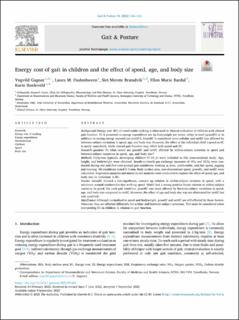| dc.description.abstract | Background Energy cost (EC) of comfortable walking is often used in clinical evaluation of children with altered gait function. EC is presented as energy expenditure per kg bodyweight per meter, either in total (grossEC) or in addition to resting energy expenditure (netEC). GrossEC is considered more reliable and netEC less affected by between-subject variations in speed, age, and body size. However, the effect of the individual child’s speed on EC is rarely considered, while altered gait function may affect both speed and EC. Research question To what extent are grossEC and netEC affected by within-subject variation in speed and between-subject variations in speed, age, and body size? Methods Forty-two typically developing children (7–15 y) were included in this cross-sectional study. Age, height, and bodyweight were obtained. Breath-to-breath gas-exchange measures of VO2 and VCO2 were conducted during rest and five over-ground gait conditions: walking at slow, comfortable, and fast speed, jogging and running. All conditions lasted 3–5 min. Body surface area, non-dimensional speed, grossEC, and netEC were calculated. Regression analyses and mixed model analyses were conducted to explain the effect of speed, age, and body size on variations in EC. Results GrossEC showed a non-significant, concave up relation to within-subject variation in speed, with a minimum around comfortable/fast walking speed. NetEC had a strong positive linear relation to within-subject variation in speed. For each gait condition, grossEC was more affected by between-subject variations in speed, age, and body size compared to netEC. However, the effect of age and body size was not eliminated for netEC but was quadratic. Significance Although normalised to speed and bodyweight, grossEC and netEC are still affected by those factors. However, they are affected differently for within- and between-subject variations. This must be considered when interpreting EC in children in relation to gait function. | en_US |

